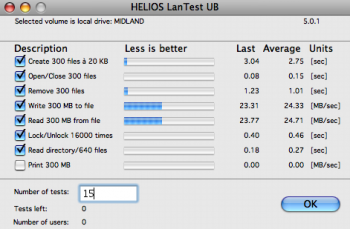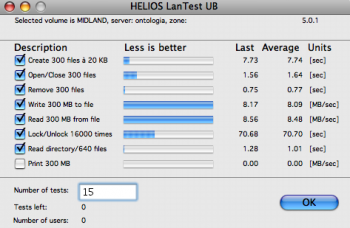To be blunt, I’ve been torn between posting this on the Server/Networking sub-forum or over here, but as it focusses mostly on legacy equipment and Ethernet protocols, the balance seems tipped to favour here.
[Mods: you’re welcome to move this over to the other sub-forum if this more appropriately belongs there.]
* * *
OK, so I want to make sense of bandwidth overhead and the hard networking limits one faces when using an older system like the iBook G3/466’s onboard 10/100BASE-T Ethernet. Those of you who’ve worked in managing and/or building enterprise network systems are probably best equipped to parse everything below.
Some background: internet service here is fibre 50Mbit/s up/down. Testing this connection with cat6 cables to my router/switch (an Asus RT-AC66U, which is equipped with four 10/100/1000BASE-T Ethernet ports for LAN use) from each of my other computers (all of which have Gigabit Ethernet capability) has no trouble reaching that 50Mbit/s benchmark via fast.com.
I hypothesized 50Mbit/s up/down could still be delivered to the clamshell, which should have plenty of headroom to handle that bandwidth on its 10/100BASE-T port, thus enabling the clamshell to access online stuff relatively quickly (prior to any processing of, say, a web page with a lot of javascript code buried within, which is going to bury the poor G3 processor).
The router correctly recognizes that that LAN port is connected to a “100M full duplex” device, and the cat6 cables used throughout the LAN are new. (MTU frame size for the iBook is the standard 1500.)
Testing: When testing the clamshell’s network connection, however, fast.com reports the up/down internet throughput, averaged (over probably a dozen tests), reaches at best 6Mbit/s [up] & 8Mbit/s [down] — way below either the 100Mbit/s bus’s ceiling or the 50Mbit internet connection, even when factoring packet overhead. More on that in a sec.
So my next benchmarking was to try the HELIOS LAN Test (which I believe was Carbonized for OS X) under two criteria: first, an actual ethernet LAN test (to the G5 file server via router/switch), and second, set up a control test by running HELIOS to the SSD boot volume within the clamshell itself — mostly to saturate its ATA-4 interface [image #1].*
Anyhow, peak throughput to the G5 server from the clamshell via HELIOS tops out at ~8.25MB/s (or, ~66Mbit/s) [image #2] — still well below the 100Mbit/s full-duplex ceiling, but far faster than the fast.com tests.


Mindful that this is old hardware, this has left me to conclude (and for anyone here to check my work):
So my question for those with the technical background:
Is it probable this bottleneck lies literally with the processor itself, or were processors from that era more than capable of saturating a 10/100BASE-T connection? I wouldn’t expect the processor to be doing that much raw work with what is little more just moving data through one of its buses (versus processing it), but maybe I’ve missed something fundamental here?
* big endnote: contrary to Everymac, which denotes this model was configured with an "EIDE/ATA-2" bus (already dubious, since S.M.A.R.T., which the iBook has, is not a part of ATA-2 spec), read/write saturation to SSD, using HELIOS, demonstrates the averaged internal throughput peaks at ~25MB/s (or, ~200Mbit/s) — in line with the NCITS 317-1998 ANSI reference sheet on the ATA-4 specification. This also places its internal ATA-4 bus squarely between a 10/100BASE-T Ethernet ceiling and the onboard FireWire 400Mbit/s ceiling.
[endnote edit/update: internal throughput peaks, following a fresh reboot, are consistently running in the ~27–28MB/s (~216–224Mbit/s) range, well within the ATA-4 / UDMA/33 specs… in case, you know, anyone was curious. See image #3 below.]

[Mods: you’re welcome to move this over to the other sub-forum if this more appropriately belongs there.]
* * *
OK, so I want to make sense of bandwidth overhead and the hard networking limits one faces when using an older system like the iBook G3/466’s onboard 10/100BASE-T Ethernet. Those of you who’ve worked in managing and/or building enterprise network systems are probably best equipped to parse everything below.
Some background: internet service here is fibre 50Mbit/s up/down. Testing this connection with cat6 cables to my router/switch (an Asus RT-AC66U, which is equipped with four 10/100/1000BASE-T Ethernet ports for LAN use) from each of my other computers (all of which have Gigabit Ethernet capability) has no trouble reaching that 50Mbit/s benchmark via fast.com.
I hypothesized 50Mbit/s up/down could still be delivered to the clamshell, which should have plenty of headroom to handle that bandwidth on its 10/100BASE-T port, thus enabling the clamshell to access online stuff relatively quickly (prior to any processing of, say, a web page with a lot of javascript code buried within, which is going to bury the poor G3 processor).
The router correctly recognizes that that LAN port is connected to a “100M full duplex” device, and the cat6 cables used throughout the LAN are new. (MTU frame size for the iBook is the standard 1500.)
Testing: When testing the clamshell’s network connection, however, fast.com reports the up/down internet throughput, averaged (over probably a dozen tests), reaches at best 6Mbit/s [up] & 8Mbit/s [down] — way below either the 100Mbit/s bus’s ceiling or the 50Mbit internet connection, even when factoring packet overhead. More on that in a sec.
So my next benchmarking was to try the HELIOS LAN Test (which I believe was Carbonized for OS X) under two criteria: first, an actual ethernet LAN test (to the G5 file server via router/switch), and second, set up a control test by running HELIOS to the SSD boot volume within the clamshell itself — mostly to saturate its ATA-4 interface [image #1].*
Anyhow, peak throughput to the G5 server from the clamshell via HELIOS tops out at ~8.25MB/s (or, ~66Mbit/s) [image #2] — still well below the 100Mbit/s full-duplex ceiling, but far faster than the fast.com tests.


Mindful that this is old hardware, this has left me to conclude (and for anyone here to check my work):
- the clear: the main bottleneck of benchmarking bandwidth throughput to/from a remote web site is likely the site’s heavy, front-end live formatting itself bogging down the processor and video card — not the internet connection and not the LAN. TenFourFox was used, since fast.com does not work with ArcticFox.
- the less clear: where the bottleneck is occurring when testing the clamshell on the gigabit LAN using HELIOS, and why bandwidth is halting at around 64Mbit/s, when MTU 1500 overhead can offer a peak data packet efficiency of 94.93% — or, a theoretical 94.93Mbit/s. I would expect maybe 80–90Mbit/s within the LAN, but this is not happening.
So my question for those with the technical background:
Is it probable this bottleneck lies literally with the processor itself, or were processors from that era more than capable of saturating a 10/100BASE-T connection? I wouldn’t expect the processor to be doing that much raw work with what is little more just moving data through one of its buses (versus processing it), but maybe I’ve missed something fundamental here?
* big endnote: contrary to Everymac, which denotes this model was configured with an "EIDE/ATA-2" bus (already dubious, since S.M.A.R.T., which the iBook has, is not a part of ATA-2 spec), read/write saturation to SSD, using HELIOS, demonstrates the averaged internal throughput peaks at ~25MB/s (or, ~200Mbit/s) — in line with the NCITS 317-1998 ANSI reference sheet on the ATA-4 specification. This also places its internal ATA-4 bus squarely between a 10/100BASE-T Ethernet ceiling and the onboard FireWire 400Mbit/s ceiling.
[endnote edit/update: internal throughput peaks, following a fresh reboot, are consistently running in the ~27–28MB/s (~216–224Mbit/s) range, well within the ATA-4 / UDMA/33 specs… in case, you know, anyone was curious. See image #3 below.]

Last edited:

